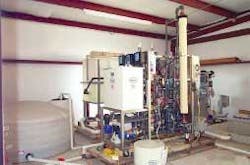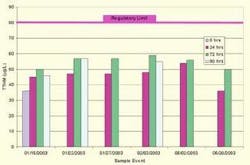Plant Turns to In-Line Coagulation with Microfiltration
By Karen R. Pappas, Jonathan Pressman and Gary Asbury
To meet increasing water demand in an area dependent on limited groundwater, the Guadalupe-Blanco River Authority (GBRA) has been working to implement a surface water supply. When operational in 2005, the Western Canyon Water Supply Project will feature a 10 mgd (expandable to 15 mgd) surface water treatment plant, serving wholesale customers in the Texas hill country. High quality filtered water, produced with minimal disinfection by-product (DBP) formation using Pall Corporation's Microza MF membranes, will be blended with the customers' existing groundwater supplies.
In a pioneering application of in-line coagulation/ flocculation pretreatment for removal of natural organic matter (NOM), a DBP precursor, coagulant doses as high as 60 mg/L will be added to remove DBP precursors prior to membrane filtration without pre-settling, complying with the Stage 1 Disinfectants and Disinfection Byproducts Rule (D/DBPR). This will enable the GBRA to meet existing water quality treatment goals without costly advanced treatment for organics removal, such as granular activated carbon (GAC), which may be added later if required.
Water Treatment Objectives
Like many new or expanded water treatment plants, water quality and treatment objectives are driven primarily by the need to supply safe, aesthetically pleasing drinking water. However, there were also some unusual project drivers. Although historical raw water has been of high quality, the treated water will largely be wholesaled to other agencies and the utmost sensitivity was required to taste and odor issues as well as to seamless blending with existing customers' chlorinated groundwater supplies. This meant employing free chlorine as the secondary disinfectant in a 40-mile transmission line, thus heightening the need to address current and future DBP regulations. In addition, the water treatment plant will provide a constant 10 mgd flow rate every day, leading to different design and operations strategies.
During preliminary engineering, environmental engineering and consulting firm Malcolm Pirnie reviewed available lake water quality, conducted bench/pilot scale evaluations, and discussed water quality and usage with customers. Based on a free chlorine disinfection strategy and these analyses, the engineers established a water age of three days after leaving the plant as an appropriate upper limit estimate of detention time in the transmission and distribution system for design purposes.
Treatment Process Evaluation
At the same time, Malcolm Pirnie conducted a process evaluation based on the established water treatment objectives. First, several candidate liquids-process alternatives including membrane filtration and conventional treatment were screened to narrow the selection to fewer alternatives for further detailed evaluation and each alternative was evaluated further based on the following criteria:
• Treatment Effectiveness
• Reliability
• O&M Requirements
• Lowest Cost
• Plant Flexibility
One alternative, installing a membrane plant and GAC with free chlorine as the secondary disinfectant, was selected based primarily on its ability to meet water quality objectives. This strategy provides superior particle reduction and protection from microbial contaminants, enables the GBRA to meet anticipated long-term regulations, and has the lowest capital cost.
After further evaluation and bench scale testing, the selected strategy was revised to delay GAC filtration to reduce initial capital costs. In place of GAC, enhanced coagulation pretreatment was incorporated upstream of the membrane system, providing sufficient total organic carbon (TOC) removal to meet the Stage 1 D/DBPR at customer taps.
Pretreatment Evaluation
Several enhanced coagulation pretreatment alternatives were evaluated including conventional flocculation/ sedimentation, in-pipe flocculation, and in-line coagulation for treatment feasibility and cost-effectiveness. Although many membrane systems require a sedimentation step during pretreatment for feed water compatibility with the membrane filters, during the past four years, several pilot systems and over a dozen full-scale systems have operated with in-line coagulation doses averaging 10 to 40 mg/L.
Malcolm Pirnie's evaluation of the advantages and disadvantages of incorporating a full conventional flocculation-sedimentation process prior to the membranes indicated that:
• Since the facility master plan includes provisions for future GAC filters to remove additional DBP precursors if needed, and current participants use a free chlorine disinfection strategy, the expense of a conventional flocculation-sedimentation process is less likely to be cost effective over the project's life. Future addition of GAC filtration downstream of the membranes would remove additional dissolved organic material and thus reduce the amount of coagulant required for pretreatment.
• The required flocculation retention time as pretreatment for membrane filtration (5-10 minutes) is less than that of a conventional flocculation process.
Bench Tests
Bench-scale testing performed during conceptual design evaluated coagulant type and dose to determine 1) the level of TOC that can be removed through enhanced coagulation and 2) the rate of DBP formation after disinfection with free chlorine.
Results indicated the point of diminishing returns for TOC removal at a coagulant dose of 50-60 mg/L, corresponding to 35-40% TOC removal. Simulated distribution system (SDS) tests, confirmed that a 60 mg/L dose of ferric sulfate could remove enough DBP precursor material from the raw water to control the formation of DBPs in the transmission and customer distribution systems.
Pilot Tests
Pilot testing of the selected treatment strategy, membrane filtration with in-line enhanced coagulation, was conducted to:
1. Demonstrate its performance for turbidity reduction, log removal of particles, and TOC removal (through pretreatment).
2. Establish full-scale design and operating parameters for use in the procurement process.
3. Confirm bench-scale evaluation results and the ability of the selected process to remove TOC and meet Stage 1 D/DBPR requirements.
4. Satisfy requirements of the Texas Commission on Environmental Quality (TCEQ) for full-scale water treatment plant design.
Seven membrane manufacturers were initially solicited for piloting, and two manufacturers participated based on the requirement for in-line coagulation.
The first stage of pilot testing was designed to establish and optimize the design and operating parameters for use in the procurement process. During the optimization piloting, raw water with no coagulant, raw water with 30 mg/L ferric sulfate and raw water with 60 mg/L ferric sulfate were each tested in succession. In addition, SDS tests were conducted on membrane system permeates during each test phase. TOC removals and SDS testing during the optimization pilot testing confirmed the previous bench-scale results.
During pilot testing, both membrane manufacturers successfully sustained operation with coagulated in-line feed while the corresponding transmembrane pressure (TMP) slope indicated that conditions would meet the minimum 30-day cleaning interval requirements.
Based on the results of the bench-scale and optimization pilot-scale testing, recommended design criteria were established for use during procurement of the membrane system. The membrane procurement was conducted using a competitive sealed bid process and because both manufacturers' equipment had already been technically verified, the low bidder, Pall Corporation, was awarded the contract for the membrane system.
In order to fulfill the remainder of the TCEQ membrane piloting requirements, a second pilot study was conducted with the contracted membrane supplier. The second stage of piloting included a 30-day simulated full-scale demonstration test at the design parameters, followed by testing for irreversible fouling (stage three piloting).
During the 30-day simulated full-scale demonstration, TOC removal was approximately 30% and UV254 removal was approximately 42%, indicating the desired removals were being achieved at the design operating conditions. Furthermore, SDS testing demonstrated DBPs were well below the regulatory limit.
Conclusions
The following conclusions were reached based on this study:
• All TCEQ membrane piloting requirements were completed, leading to the establishment and demonstration of full-scale operating parameters.
• Finished water quality goals were achieved with an in-line coagulant dose of 60 mg/L ferric sulfate.
• TOC and UV254 reductions indicated significant removal of DBP precursor materials and successful operation of the pretreatment system.
• SDS testing resulted in THM and HAA concentrations well below regulatory limits.
• Spikes in raw water turbidity and particle counts had little effect on finished water quality.
• Stage 3 post cleaning tests demonstrated that there was no observed irreversible fouling.
Following the pilot testing, the membrane water treatment plant was designed and construction will begin prior to summer 2004.
About the Authors:
Karen R. Pappas, P.E., is a senior project engineer with Malcolm Pirnie, Inc. in San Antonio, TX. With a focus on municipal drinking water and wastewater treatment projects, she has conducted many facility planning and design projects including bench and pilot-scale treatment studies for advanced treatment processes. Jonathan Pressman, Ph.D., is a project engineer with Malcolm Pirnie, Inc. in Austin, TX. Through research and consulting he has acquired considerable experience with membrane technology and microbiology for environmental engineering applications. Gary Asbury, P.E., is manager of project engineering for the Guadalupe-Blanco River Authority in Seguin, TX. With over 27 years of municipal engineering design and construction management experience, he is responsible for the design and construction management of the Authority's major capital improvement projects.


